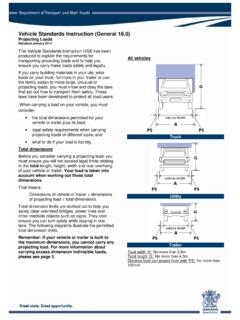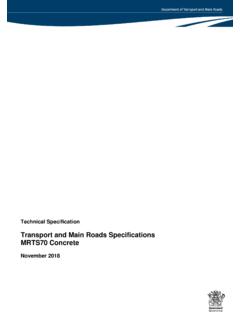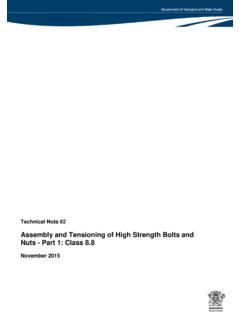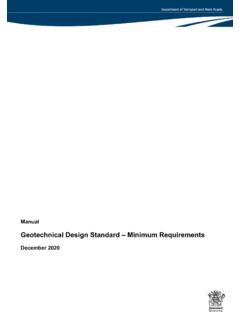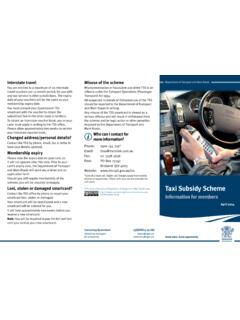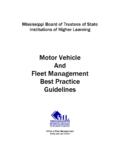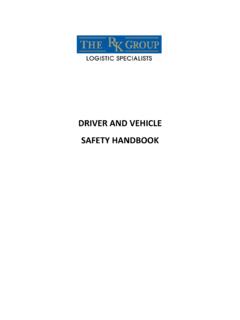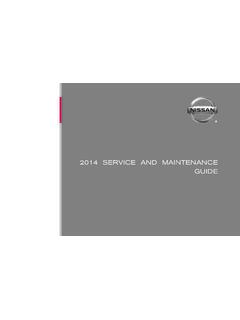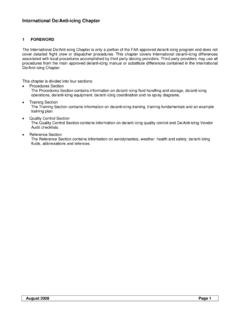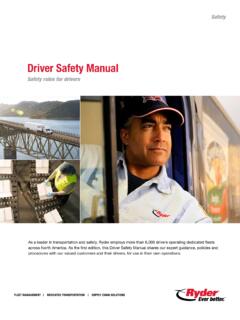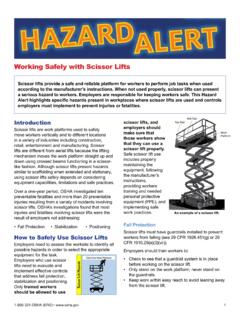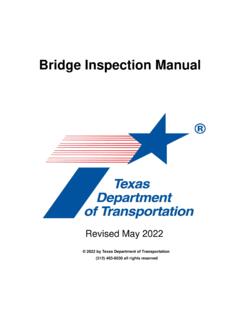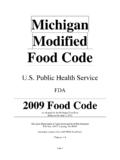Transcription of VEHICLE INSPECTION GUIDELINES CONTENTS
1 Page 1 SECTION 2 VEHICLE INSPECTION GUIDELINES CONTENTS 1. IDENTIFICATION 2 2. MODIFICATIONS 4 3. LIGHT VEHICLES 7 SEATS AND RESTRAINTS 7 LIGHTS AND ELECTRICAL COMPONENTS 9 WINDSCREEN AND GLAZING 13 BODY AND CHASSIS 16 TOW COUPLINGS 19 STEERING AND SUSPENSION 20 WHEELS AND TYRES 25 BRAKES 29 ENGINE/DRIVE LINE/EMISSIONS 32 4. HEAVY VEHICLES 38 SEATS AND RESTRAINTS 38 LIGHTS AND ELECTRICAL COMPONENTS 40 WINDSCREEN AND GLAZING 43 BODY AND CHASSIS 46 TOW COUPLINGS 49 STEERING AND SUSPENSION 50 WHEELS AND TYRES 54 BRAKES 57 ENGINE/DRIVE LINE/EMISSIONS 60 5. TRAILERS 65 LIGHTS AND ELECTRICAL COMPONENTS 65 BODY AND CHASSIS 67 TOW COUPLINGS 68 STEERING AND SUSPENSION 70 WHEELS AND TYRES 72 BRAKES 74 6.
2 MOTORCYCLES 79 SEATING 79 LIGHTS AND ELECTRICAL COMPONENTS 79 BODY AND CHASSIS 82 TOW COUPLINGS 84 STEERING AND SUSPENSION 85 WHEELS AND TYRES 88 BRAKES 90 ENGINE/DRIVE LINE/EMISSIONS 93 7. ROAD TEST ALL VEHICLES 98 Page 21. IDENTIFICATION OBJECTIVE: To verify the VEHICLE s identity. GENERAL Identification must be obtained from the VEHICLE and not from registration documents or the VEHICLE owner s manual. All sections of the Certificate must be completed and legible. (See Note 5) DATE OF MANUFACTURE Must be entered (month and year) on the Certificate as shown on the compliance plate or VEHICLE identification plate. (See Note 1) ENGINE NUMBER Must not be altered and is to be recorded on the Certificate.
3 (See Note 2) VIN/CHASSIS NUMBER Must not be altered and is to be recorded on the Certificate. (See Note 2) COMPLIANCE PLATE Must be fitted to vehicles manufactured after 1 January 1972 (1 July 1975 for motorcycles). (See Note 3) TRAILER PLATE All trailers manufactured on or after 1 July 1988 must display a "trailer plate" fixed in a prominent external position. The trailer plate must show: the manufacturer s name and trailer model number; VEHICLE identification number (VIN); date of manufacture and aggregate trailer mass. (See Note 4) REGISTRATION PLATES (WHEN FITTED) Must be in good condition, legible and free from visual obstruction. Page 3 ODOMETER Reading must be entered on the Certificate.
4 NOTES: (1) Some vehicles may have a compliance (manufacture) date which may differ to "Built Date" shown on the build date plate. Pre January 1972 vehicles may not have a compliance plate. (2) If the examiner considers that the Chassis Number, Compliance Plate or Body Number has been tampered with, a "Fail" is to be recorded for identification. If an engine or chassis number is not stamped, the VEHICLE is to be rejected and the owner must be advised to contact the nearest Queensland Transport office to obtain a new number. (3) Compliance plates may take the form of a private import (yellow) or low volume (green) compliance plate issued by the Federal Office of Road Safety.
5 Alternatively, a permit which exempts the VEHICLE from the Transport Operations (Road Use Management) Regulation may be issued, if applicable, or a modification plate displaying Code LO1 must be fitted. Refer to AIS Information Sheet 5 relating to Missing Compliance Plates for further details. (4) This is required even if a separate VIN plate is attached. (5) VEHICLE definitions are provided in AIS Information Sheet 14. Page 42. MODIFICATIONS OBJECTIVE: To check that any modifications have been carried out in an approved manner. MODIFICATIONS NOT REQUIRING AUTHORISATION Modifications referred to in the brochure "All About Modifications to Motor Vehicles" that have been satisfactorily performed and will not make the VEHICLE defective, are permitted.
6 (See Note 1) MODIFICATIONS REQUIRING AUTHORISATION Modifications must have been performed in accordance with the Light/Heavy Commercial VEHICLE Code of Practice or as otherwise approved by Queensland Transport. Modifications which would adversely affect the safety of the VEHICLE are not permitted. If the examiner is unsure about the legality of the modification, he should consult an Approved Person or Queensland Transport. MODIFICATION PLATE/APPROVAL LETTER (See Note 2) A modification plate correctly identifying the modification must be securely attached to the VEHICLE , or an approval letter/certificate for the modification duly endorsed by a Queensland Transport Inspector must be sighted.
7 Modification plates must be stamped or engraved with all relevant codes and details of the modifications. Modification plates must be fitted as near as practicable to the compliance plate. ILLEGAL MODIFICATIONS Modifications which would adversely affect the safety of the VEHICLE are not permitted. GAS CERTIFICATE FOR MOTOR FUEL INSTALLATION Refer to AIS Information Sheet 6 for additional information regarding Liquefied Petroleum Gas (LPG) and Compressed Natural Gas (CNG) certification. (See Note 3) Page 5 NOTES: (1) A VEHICLE is defective if: (a) a part of the VEHICLE that is necessary for the safe operation of the VEHICLE - (i) does not perform its intended function; or (ii) has deteriorated to an extent where it can not be reasonably relied on to perform its intended function; or (b) a part of the VEHICLE that is necessary for the control of emissions of gas, particles or noise - (i) does not perform its intended function; or (ii) has deteriorated to an extent where it can not be reasonably relied on to perform its intended function.
8 Or (c) the VEHICLE s odometer - (i) does not perform its intended function; or (ii) has deteriorated to an extent where it can not be reasonably relied on to perform its intended function; or (d) the VEHICLE is unsafe; or (e) the VEHICLE does not comply with the Code of Practice - VEHICLE INSPECTION GUIDELINES (the " VEHICLE INSPECTION code of practice") (2) A special modification plate relates to motorcycles. A list of modification codes are included in Information Sheets 1(a) and 1(b). If the examiner is unsure about the legality of the modification, he should consult an Approved Person or Queensland Transport. (3) Regulation 99 of the Gas Regulations 1989 requires that: "The appliances, containers and other fittings and systems installed in all motor vehicles, caravans and vessels shall be inspected within one month prior to delivery of possession to any person pursuant to any sale or other transfer of ownership".
9 Page 6 With the Safety Certificate now having a life of up to three (3) months and to ensure that certificates have the same life and to avoid confusion, the Chief Gas Examiner has approved, subject to Regulation 122 of the Gas Regulation 1989, that certificates prepared for the sale or other transfer of possession shall apply for a period of one month or for the period of the Queensland Transport Safety Certificate, whichever is the longer. Motor VEHICLE or caravan gas installations must have the installation and any subsequent alterations certified by a licensed gas installer. Page 73.
10 LIGHT VEHICLES SEATS AND RESTRAINTS OBJECTIVE: To ensure that all seating and restraints fitted to the VEHICLE provide a comfortable and secure position for the driver to control the VEHICLE and control the deceleration of all VEHICLE occupants. SEATING Reasons for rejection: Seat cushions, backrests, head restraints and seat frames are not fitted, not secure, are structurally damaged, have sharp or jagged edges, or protrusions. A seat slide or other seat control used for adjustment of a seating position is not operational and does not hold any selected position allowed for in the mechanisms design. Any reduction or increase in seating capacity is not certified by an Approved Person.


